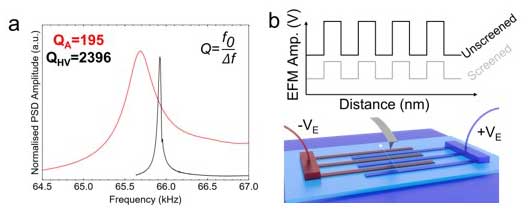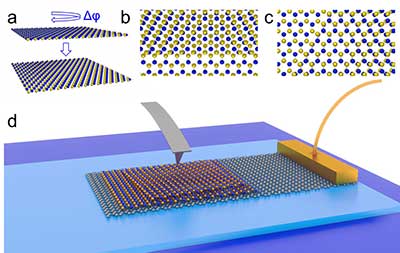J. Kerfoot1*, V. V. Korolkov1
1 Park Systems UK Ltd, MediCity Nottingham, D6 Thane Rd, Nottingham, UK, NG90 6BH
* pse@parksystems.com
Overview
The fabrication of ferroelectric superlattices in layered materials through the deterministic formation of specific interlayer registries has received significant recent attention in the context of both scanning probe microscopy and graphene-based devices. Atomic force microscopy (AFM) is an ideal tool to probe such phenomena as it possesses sub-nanometre spatial resolution and offers several modalities which enable a range of functional properties (e.g., piezoelectricity, work function, current) to be mapped spatially. By performing such measurements in high vacuum using the Park Systems NX-Hivac, the exceptional utility of AFM to study ferroelectricity on the nanoscale is demonstrated.
Performing AFM under high vacuum conditions offers three primary advantages over measurements performed under ambient conditions. Firstly, the sample can be maintained in a controlled environment, which is beneficial for air sensitive samples and the general reproducibility of measurements. Secondly, the mechanical damping of the cantilever oscillation is suppressed, which leads to superior cantilever response and significantly higher quality factors in high vacuum (see figure 1a). This is particularly pertinent when addressing higher eigenmodes of the cantilever which may not be accessible under ambient conditions. Thirdly, the formation of atmospheric adsorbates at interfaces is suppressed, which enhances the sensitivity of electrical AFM modes by reducing electrostatic screening and reduces the influence of mobile interfacial contaminants in topographic measurements (see figure 1b). Here, we perform both topographic and electrostatic AFM measurements of ferroelectric parallel stacked hexagonal boron nitride (hBN) under high vacuum and demonstrate contrast of ferroelectric domains in electrostatic imaging modes superior to those measured under ambient conditions.

Figure 1. Comparing the resonance curve of the 1st eigenmode of an ElectriMulti75-G cantilever under ambient conditions (red) and at ~1x10-6 mbar (black) reveals a superior mechanical response in vacuum (a).
In addition, the accumulation of interfacial contamination under ambient conditions leads to screening which suppresses the signal in electrostatic AFM modes (b).
A sample consisting of two parallel stacked hBN flakes exhibiting a ferroelectric superlattice [1] on graphene was prepared by micromechanical cleavage and transfer using a home-built transfer system [2] for layered materials heterostructures with polycarbonate stamps [3]. The ferroelectricity of the parallel stacked interface arises from the formation of unpaired out-of-plane dipoles between overlying boron and nitrogen species [1] (see figure 2). Immediately before high-vacuum measurements, the overlap area between the flakes was scanned using contact mode AFM in order to remove any organic contaminants from the top hBN surface. The probe was subsequently changed (ElectriMulti75-G) before the system was pumped to high vacuum (~1x10-6 mbar), under which conditions electrostatic force microscopy (EFM) and KPFM were performed.

Figure 2. Assembling layered materials heterostructures with a controlled twist angle (a) allows parallel stacked registries to be formed (b) which differ from the registry of as-synthesised bulk hBN (c).
Ferroelectricity in parallel stacked hBN on graphene may then be probed on the nanometre scale using atomic force microscopy (d).
As has been reported for such parallel stacked domains measured under ambient conditions [1,4,5], we observe contrast over the ferroelectric domains using both EFM (figure 3b) and KPFM (figure 3c). This contrast arises from the interaction of the electrically driven metal coated AFM probe with the out-of-plane electric fields of the ferroelectric domains. In the case of KPFM measurements of parallel stacked hBN on graphene measured in high vacuum, we extract a contact potential difference (CPD) contrast from amplitude modulated (AM)-KPFM images of 130 mV, compared to 110 mV for images acquired under ambient conditions. We attribute the higher contrast in vacuum-based AM-KPFM to the reduction of screening from airborne contaminants which naturally accumulate at interfaces under ambient conditions.

Figure 3. The topography (a), electrostatic force microscopy phase (b) and CPD measured using amplitude modulated KPFM (c) of parallel stacked hBN measured with VEFM=4 V and fEFM=17 kHz at high vacuum
(~1x10-6 mbar).
Conclusion
Performing measurements in high vacuum enables favourable cantilever dynamics and suppresses the influence of interfacial contamination [6]. In the case of ferroelectric parallel stacked hBN, improved signal-to-noise in electrostatic AFM modes enables more detailed exploration of ferroelectric systems, with direct applications to both electronic devices with switchable ferroelectric states and scanning probe microscopy based experiments exploring the interlayer interactions and mechanical and electrical switching properties of domains.
References
[1] C. R. Woods et al. Nat Commun. 12, 347 (2021)
[2] Q. Zhao et al. J. Phys. Mater. 3 016001 (2020)
[3] D. G. Purdie et al. Nat. Commun. 9, 5387 (2018)
[4] M. Vizner Stern et al. Science 372, 1462-1466 (2021)
[5] K. Yasuda et al. Science 372, 1458-1462 (2021)
[6] O. Kazakova et al Nanotechnology 24 215702 (2013)




